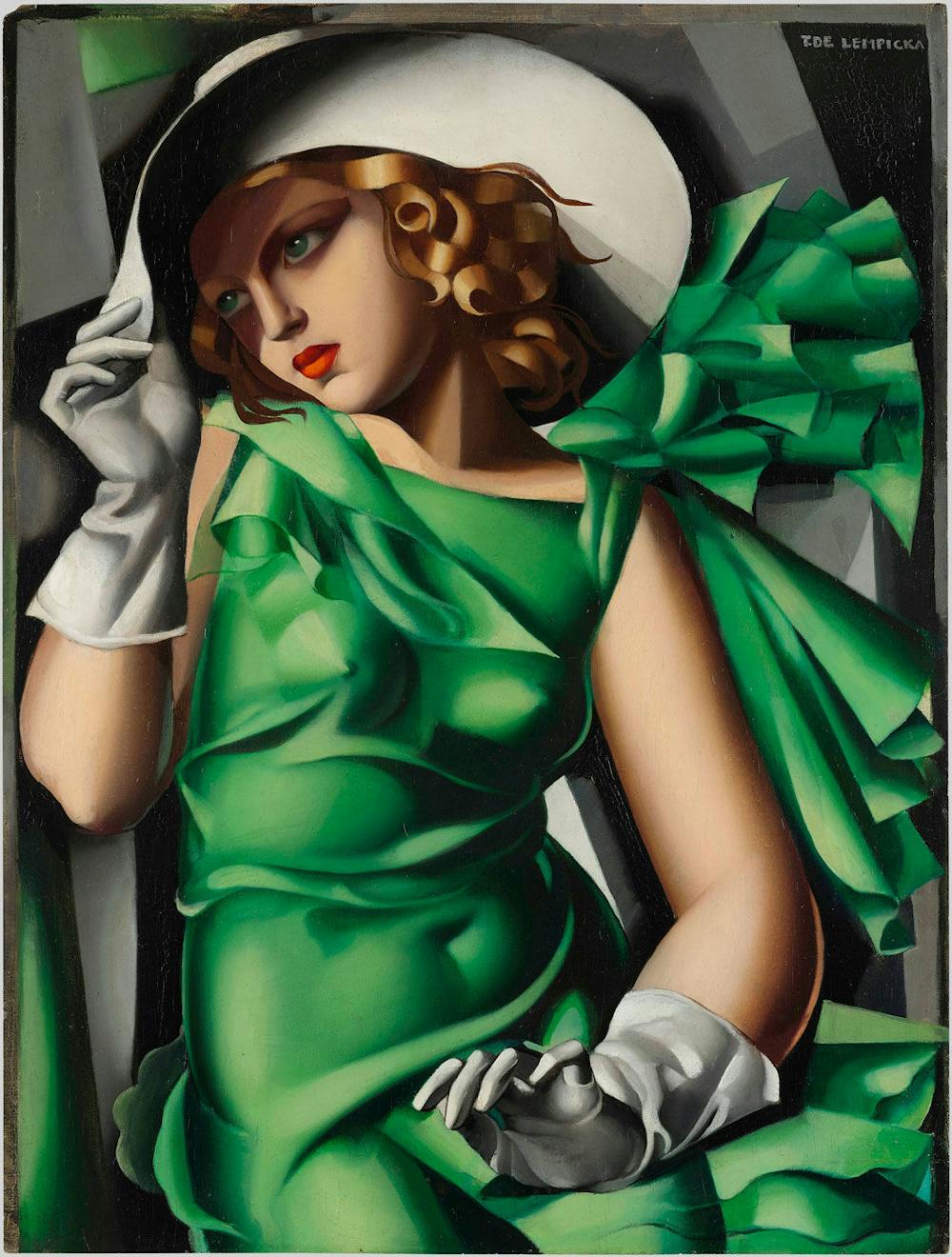Review: ‘Tamara de Lempicka’ fashions survival at MFAH

Score: ★★★★★
Houstonians first knew her as Baroness Kuffner, the mother of prominent socialite Kizette Foxhall, noted for her chainmail dresses and resemblance to Greta Garbo in the Houston Chronicle.
This spring, Houston was reintroduced to her as Tamara de Lempicka, the Art Deco portrait painter renowned for her cosmopolitan flair and unconventional glamour.
An American museum retrospective of her work is now at the Museum of Fine Arts, Houston, traveling from the de Young Museum in San Francisco.
“Tamara de Lempicka” gathers the titular artist’s most iconic portraits of interwar Parisian high society, synthesizing Cubist approaches with Mannerist and Neoclassical sensibilities — think angular shapes, theatrical lighting and lush fabrics — alongside her later, lesser-known works during her time in New York and Los Angeles.
The retrospective celebrates the modern woman and the stagecraft of her appearance. As ordained by Vogue in 1929: “She knows that in the drama of her own personality she must be stage director, scene shifter, mistress of costumes, as well as star of the play.”
Here, the modern woman is presented as a self‑made spectacle, each gesture and object selected with directorial precision.
Lempicka embodies this ethos in her 1930 portrait of her lover Ira Perrot: Perrot leans, draped in a red shawl that falls like velvet curtains, holding calla lilies as though they were stage props.
Every fold of fabric is positioned to catch the light: her hair flows in ribbon‑like waves and the taut musculature of her abdomen, visible beneath white silk, resembles sculptured marble — every detail selected to heighten the moment’s drama.
Across the exhibition, no subject is present more consistently or deliberately than Perrot, Lempicka’s leading lady in her production of the modern woman.
Draped in Schiaparelli dresses and other high-fashion finery, Lempicka became a darling of Parisian high society.
A refugee — first from the Bolsheviks during the Russian Revolution, then the Nazis at the outbreak of World War II — she understood that her survival depended on a relentless reinvention of self.
She concealed her gender, motherhood, Jewish identity and eventually, herself from public eye — the practice of self-fashioning as a queer act of rebellion.
“I live life in the margins of society, and the rules of normal society don’t apply to those who live on the fringe,” Lempicka once said.
Her self-fashioning was a disavowal of those very conventions. Here was a woman who understood that her public persona was a performance as carefully crafted as any magazine spread. Style, after all, was her means of sustenance.
Alison de Lima Greene, the Isabel Brown Wilson Curator of Modern and Contemporary Art at the MFAH, said Lempicka was a maverick in recognizing the need for artists to use their public presence as a marketing tool without a powerful art dealer backing her.
“She was pretty much on her own, although admittedly assisted in later years by her second husband’s [Baron Kuffner’s] considerable wealth and the profits she gained from selling her paintings in the 1920s and 1930s,” Greene wrote in an email to the Thresher. “She was an astute businesswoman and then when her work fell out of favor, she withdrew from the public eye while nonetheless continuing to paint.”
Her adoption of Catholic iconography offered another means to fashion herself — in this case, to conceal her Jewish identity amid Nazi-occupied France.
In “The Communicant,” for instance, she depicts her daughter, Kizette, in a stark white ceremonial dress evoking a child’s First Communion, despite Kizette’s admission that she had never actually taken communion.
This retrospective, beyond serving as a reintroduction of Lempicka’s mastery to modern audiences, was also a homecoming.
After Kuffner’s death, she withdrew from an art scene she dismissed as being overrun by pop and op art, which she described as “pollution brought on by the contemporary sub-culture.”
Finding a second home in Houston, Greene said Lempicka withdrew from the art world in exchange for stillness, reinventing herself once more.
“Tamara de Lempicka started visiting Houston on a regular basis in the 1950s after her daughter settled here, and after her husband died she kept an apartment too,” Greene wrote. “[S]he never exhibited in any of our institutions. That said, she loved theatre and music, and attended many concerts and performances.
“The social pages in the Houston Post and Houston Chronicle often reported on the premieres she attended, as well as the couture she wore,” Greene continued. “However, she did leave a different kind of legacy, donating antiques from her husband’s estate to Rice University, and several old master paintings to the Teaching Collection at the University of St. Thomas (these are now in The Menil Collection).”
Lempicka’s life of constant self-reinvention is the throughline across her oeuvre. The result is nothing short of magnificent. My advice: take the audio tour.
“Tamara de Lempicka” is on view through May 26 at the Museum of Fine Arts, Houston.
More from The Rice Thresher

West brothers value faith and family sharing the field
When Robyn and Greg West enrolled their sons in T-ball, they said they saw baseball as a way to keep the boys out of trouble. Eighteen years later, brothers Graiden and Landon West compete at the Division I level for Rice’s baseball team.

“You need a therapist, not a keyboard”: Loretta Ross on calling in
Loretta Ross jokes that she can “talk as long as Fidel Castro.” These days, her urgency is reserved for speaking against the 'call out' — the act of public shaming as a corrective measure — which she said has become as "inevitable as gravity” during her lecture at Duncan Hall on April 14.

Review: ‘Daredevil: Born Again’ struggles with identity but shows promise
Following Netflix’s acclaimed third season of "Daredevil," expectations were understandably high for Marvel’s new Disney+ continuation, "Daredevil: Born Again." Unfortunately, the series suffers noticeably from a split personality, caught between excellence and confused mediocrity.

Please note All comments are eligible for publication by The Rice Thresher.